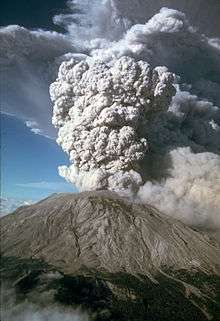Ejecta

Ejecta (from the Latin: "things thrown out", singular ejectum) are particles ejected from an area. In volcanology, in particular, the term refers to particles including pyroclastic materials (Tephra) that came out of a volcanic explosion, volcanic vent, or crater, has traveled through the air or under water, and fell back on the ground surface or on the ocean floor.
Volcanology
Typically in volcanology, ejecta is a result of explosive eruptions, in an explosive eruption, large amounts of gas is dissolved in extremely viscous lava, this lava froths to the surface until the material is expelled rapidly due to the trapped pressure. Sometimes in such an event there’s something called a lava plug or volcanic neck which is lava that has solidified inside of a lava tube, this causes heat and pressure build up to an extreme due to the trapped pressure with no way to escape. Once the pressure or rock can't sustain itself any longer a more violent eruption occurs which allows these different types of materials to be "ejected" out of volcano. [1][2]
Ejecta can consist of:
- juvenile particles – (fragmented magma and free crystals)
- cognate or accessory particles – older volcanic rocks from the same volcano
- accidental particles – derived from the rocks under the volcano
These particles may vary in size, tephra can range from ash (<1/10in), lapilli (little stones from 1/10 in to 2 ½ in) or volcanic bombs (2.5 in+). [3]
Planetary geology
In planetary geology, this term includes the debris that is ejected during the formation of an impact crater, while in astrophysics, it refers to material expelled in a stellar explosion as in a supernova or in a coronal mass ejection.[4][5][6]
When an object that is massive enough hits another object with enough force strikes another body, it creates a shockwave that spreads out from the impact, the object breaks and excavates into the ground and rock, at the same time spraying this material that is known as impact ejecta. This ejecta is distributed outward from the craters rim onto the surface as debris, it can be loose material or a blanket of debris, which thins at the outermost regions. [7]
If enough ejecta are deposited around an impact crater, it can form something known as an ejecta blanket, this blanket is full of dust and debris that originated from the initial impact. The size of this impact crater along with the ejecta blanket can be used to determine the size and intensity of the object. The ejecta blanket around an impact crater on titan can be seen below. On earth, these ejecta blankets can be analyzed to determine the source location of the impact. [8]
A lack of impact ejecta around the planet Mars' surface feature Eden Patera was one of the reasons for suspecting it was collapsed volcanic caldera not an impact crater in the 2010s.[9]
References
- ↑ [http://www.landforms.eu/Lothian/volcanic%20neck.htm ], Volcanic Neck, Volcanic Plug, USGS.
- ↑ [http://chis.nrcan.gc.ca/volcano-volcan/hazard-risque-en.php?wbdisable=true ], Ejecta, Natural Resources Canada.
- ↑ [http://volcano.oregonstate.edu/glossary/1/letterl#term74 ], Oregon State University Glossary.
- ↑ Matheson, Heather; Safi-Harb, Samar (2005). "The Plerionic Supernova Remnant G21.5-0.9: In and Out" (PDF). Advances in Space Research. 35 (6): 1099. arXiv:astro-ph/0504369. Bibcode:2005AdSpR..35.1099M. doi:10.1016/j.asr.2005.04.050. Archived from the original (PDF) on 2012-07-17. Retrieved 2013-09-15.
- ↑ "The Advanced Satellite for Cosmology and Astrophysics (ASCA)". Hera.ph1.uni-koeln.de. Retrieved 2013-09-15.
- ↑ "ASCA". Archived from the original on 2006-05-01.
- ↑ [https://www.lpi.usra.edu/education/explore/shaping_the_planets/impact-cratering/ ], Lunar and Planetary Institute.
- ↑ [https://www.nasa.gov/mission_pages/cassini/multimedia/pia07368.html ], Titan Impact Crater.
- ↑ Amos, Jonathan (2013-10-02). "Supervolcanoes ripped up early Mars". BBC News. Retrieved 2017-02-12.